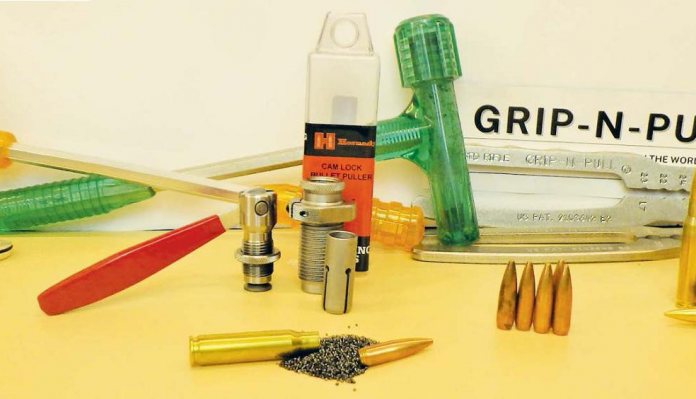When reloading goes wrong
-
399
 Comments
Comments
- Last updated: 25/01/2022

There are several reasons for having to disassemble ammunition, including an upside-down primer, a missed powder charge, ammo that just will not perform or even ammunition of unknown provenance. There is a wide selection of tools available for the job, from a simple pair of pliers, to more expensive, on-press tools.
As with all aspects of reloading, safety is paramount and you should always wear eye protection. You must also avoid subjecting the rounds, and in particular the primers, to direct impact or friction as this could cause the primer to ignite.
Definitely not recommended, some reloaders simply grab the bullet and the case with pliers and pull them apart. As well as destroying both of the components, there is a good chance you will spill powder everywhere, which is unsafe. Occasionally, you might see someone disposing of a .22 rimfire round that has failed to fire by this method, and they do pull apart very easily, but for centrefire rounds, this is not a good idea.
Described by the manufacturer as “the best bullet puller in the world”, this device is used in conjunction with a single-stage press to pull the round apart. With the case securely held in the appropriate shell holder, the ram is raised so that the bullet sticks up above the die-hole in the press, where it is then gripped by the appropriately sized hole (four sizes are available to cover most common calibres) in the GRIP N PULL tool. With the bullet securely gripped, the ram is lowered and the case is pulled down and off the bullet. The case and the bullet are undamaged, and therefore reusable. For this tool to work, there needs to be enough flat bearing surface of the bullet exposed above the rim of the case to get hold of, because it struggles to grip the ogive section of the bullet.
As the name suggests, this type of bullet puller uses impact to cause the bullet and case to separate. The tool looks like a hammer, with an elongated and hollow head and an opening at one end, where the round is inserted and held in a collet. When the head of the tool is struck against a solid surface, the case is held in place, but the instant deceleration on impact causes the bullet to continue forward (with kinetic energy) and to leave the mouth of the case. The bullet and the powder charge are retained in the front of the tools head, and the case is held by the collet gripping it by the base. Soft nosed bullets can be damaged when they hit the inside of the tool and be rendered unusable. To prevent this, a small piece of padding, like a simple disposable earplug, can be inserted into the bullet puller to act as a cushion against the force of the impact. Surprisingly, no kinetic bullet puller manufacturers supply their tools with padding built-in.
This is a more ‘gentle’ method of dismantling ammunition and also uses a single-stage press to do the job. With a round placed in the shell holder, the ram is raised and the bullet enters the bullet puller and the calibre-specific collet inside. The lever on top of the tool is pulled forward and the collet grips the bullet so that when the ram is lowered, it is retained and the case is pulled down and off. This tool does the job easily and cleanly and all of the components are reusable.
Once you have pulled your defective rounds apart, you can consider reusing the separated components.
If you are 100% sure you know what the powder is, then you can empty in into a suitable container and re-use it. If you do not know what it is, then dispose of it carefully.
You then have a primed case and under no circumstances should you attempt to remove the primer using a sizing/depriming tool, as it may ignite when the depriming pin hits it. If you remove the depriming pin you can resize the case and reload it again, saving this most expensive of the reloading components.
Some reloaders will remove a live primer by putting a few drops of nitrosolvent in the case, leaving it for 24 hours to destroy the primer compound, and then depriming the case as if it held a spent primer. If you do try this method you must wear eye protection and use a universal decapping die, which has a large internal space to ‘deflect’ any accidental detonation. I do not recommend attempting to remove a live primer from a case by any method. You can simply fire the primed case off next time you are at the range, without powder or bullet, or destroy the primer compound as detailed above and then simply throw the case away.
If the bullet has been removed without damage, then it can be reused. Soft lead bullets do not tend to survive any of the above methods of removal, as they are often dented or distorted too badly to be reused. Jacketed bullets, particularly those with very thin copper jackets and soft led cores, can also be damaged during extraction. Examine every bullet that has been pulled and if they are undamaged then they can be recycled.
When things go wrong, defective rounds are generally easily dealt with by using any of the above methods, and it is well worth having a bullet puller on your bench. The kinetic type is the cheapest and, with a pad in the head, the components are all reusable. The Hornady Cam-Lock bullet puller is more expensive, and the build quality is excellent, but the components are separated in perfect condition every time.
Hornady Cam-Lock Bullet Puller - www.edgarbrothers.com
GRIP N PULL Bullet Puller - www.grip-n-pull.com
Smart Reloader Kinetic Bullet Puller - www.henrykrank.com
